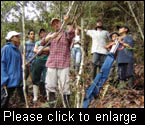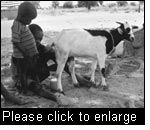InfoResources
News No 4 / 06 (August 2006)
Special feature
> Clean Development
Mechanism in forestry and poverty reduction
Policy
> Livestock
provides security and new opportunities for the poor
> Supporting
legal tropical forest harvesting
> What we do to the environment
lashes back at our health
> Are free trade, environmental concerns and
human rights
incompatible?
Implementation
> Between appropriation
and expropriation
> Poverty and
Conservation: An information portal to bridge the gaps
> Mali farmers
in control of their extension services
> Roads against
poverty
> Rural
innovation in Central America
Expert's opinion
> Rice: The
focus should be on the farmer rather than the plant
Special Feature
Clean Development Mechanism in forestry and poverty reduction
 The
Clean Development Mechanism (CDM) of the Kyoto Protocol allows industrialised
countries (Annex I countries) to acquire Certified Emission Reductions
(CERs) by implementing projects in developing countries. The CERs credited
correspond to the reduction in greenhouse gas emissions that a given
project achieves or the carbon that a forestry project temporarily removes
from the atmosphere. Industrialised countries can use these CERs to
fulfil their reduction commitments. Every CDM project is required to
promote sustainable development according to the priorities of the concerned
developing country. The
Clean Development Mechanism (CDM) of the Kyoto Protocol allows industrialised
countries (Annex I countries) to acquire Certified Emission Reductions
(CERs) by implementing projects in developing countries. The CERs credited
correspond to the reduction in greenhouse gas emissions that a given
project achieves or the carbon that a forestry project temporarily removes
from the atmosphere. Industrialised countries can use these CERs to
fulfil their reduction commitments. Every CDM project is required to
promote sustainable development according to the priorities of the concerned
developing country.
In forestry, only tree-planting on land that has been without forest
since at least 1990 is eligible as afforestation or reforestation CDM
projects. Projects that prevent deforestation or implement sustainable
forest management are not yet eligible.
Key questions are:
- How can CDM projects improve the living conditions of the rural
poor?
- Are there examples that demonstrate this potential?
- What exactly is it that makes the difference for the rural poor?
The San Nicolas Project in Colombia was designed with
these questions in mind. Implemented since 2001, the project aims to
use the CDM's potential for promoting sustainable management of the
forest landscape and, at the same time, to improve the livelihoods of
the 12,000 families directly involved.
Today, it is possible to mention some outcomes. The region now has a
master forest development plan adopted by the local farmers, who also
actively participated in designing it. The plan integrates a CDM reforestation
component and the use of timber and non-timber products. The CDM component
includes 6 agroforestry systems, 1 silvopastoral system and several
small plantations. By 2008, trees will have been planted on more than
2,500 ha of land, creating a new source of income for the community.
In addition, the project involves activities regarding the management
of existing forests, as well as capacity-building and entrepreneurship
programmes that cover new products and markets. Beneficiaries of these
programmes are now selling products based on non-timber products such
as shampoo, soap, and essential oils. A key player in the CDM, the BioCarbon
Fund of the World Bank, is finalising negotiations with MASBOSQUES,
a public-private partnership that unites the owner of the local forests
(mainly small farmers), local NGOs, governmental institutions and the
municipalities in the San Nicolas region.
Success in San Nicolas is based on participation and empowerment of
the local community, along with high-quality documentation. Can other
rural communities in developing countries also use the CDM to promote
poverty reduction and sustainable development in rural areas?
A positive answer to this question is indicated by other relevant arguments
aside from the experience made in San Nicolas – for example, the
availability of approved methodologies that ease the process of designing
a CDM forestry component project. With regard to poverty reduction,
the simplified modalities, procedures and methodology for small-scale
project activities (SSC/AR) are of great importance. The SSC/AR are
aimed at facilitating the participation of poor communities in the CDM.
The CDM alone does not ensure empowerment of local communities, nor
does it reduce poverty per se. Development cooperation can promote both
participation and empowerment, on the one hand, and capacity-building
for the CDM, on the other hand, thus ensuring that the poor benefit
from CDM forestry components. Thus, it can be an important additional
element that helps to achieve these development objectives in rural
areas.
Sources:
> Alternative financing model for sustainable forest management
in San Nicolas. www.tropicalforest.ch/project.php?id=18
> Approved A/R Methodologies. UNFCC.
http://cdm.unfccc.int/methodologies/ARmethodologies/approved_ar.html
> Catalyzing Markets for Climate Protection and Sustainable
Development. Colombia: San Nicolas Agroforestry. The World Bank Carbon
Finance Unit.
http://carbonfinance.org/Router.cfm?Page=Projport&ProjID=9630
> MASBOSQUES. Corporación para el Manejo Sostenible de
los Bosques. www.masbosques.org.co
Note:
This project has been co-financed by the International Tropical
Timber Organisation (ITTO, with Switzerland-seco as a major donor),
the Corpración Autónoma Regional del Rionegro-Nare (CORNARE),
and the Swiss Federal Laboratories for Material Testing and Research
(EMPA).

Policy
Livestock provides security and new opportunities for the poor
 A
new publication by LivestockNet shows that livestock production can
make an important contribution to achieving the Millennium Development
Goals. A
new publication by LivestockNet shows that livestock production can
make an important contribution to achieving the Millennium Development
Goals.
Livestock often takes on the function of a “bank” for poor
population groups, who use the animals as savings that they can fall
back on in times of crisis. At the same time, livestock generates additional
income that can be used to cover the costs of education or health services.
Livestock also provides important components of a healthy diet. In agriculture,
the animals provide traction and important nutrients for fertilising
the fields. For women, in particular, livestock production offers an
independent income opportunity and a possibility to raise their social
status.
Despite this potential, livestock productivity is usually rather low.
Small-scale farmers often lack access to new technologies, as well as
opportunities to sell their products profitably. In order for livestock-based
development initiatives to be sustainable, they must take account of
possible adverse effects: excessive intensification of production can
have negative impacts on the environment; livestock production is fairly
labour-intensive; moreover, it can interfere with crop production.
Source: Livestock Production and the
Millennium Development Goals: The role of livestock for pro-poor growth.
LivestockNet, May 2006. 20 pp.
www.livestocknet.ch/pdfs/LsN_MDGs_final.pdf
Supporting legal tropical forest harvesting
Verifor, a forest verification project, supports EU partners in tropical
countries in their efforts to ensure legal harvesting of their forests,
notably for commercial use.
Its aim is to foster the development of verification institutions in
these countries, which must be country-specific, representing the civil
society and observe the principles of good governance. Consequently,
the project focuses on the dissemination of research findings and the
promotion of knowledge about verification systems targeting governments
of forest-rich countries, the forest industry, civil society groups
and the international development community.
In addition to these services, the Verifor site has recently started
with a new column: “Controversies”, which hosts critical
articles on the verification debate. For example, one article criticises
that little attention is given to social issues, in particular to poverty
while the interests of the wealthy and powerful are protected.
Source: The Verifor Project.
Options for forest verification.
www.verifor.org

What we do to the environment lashes back at our health
Today, already 60% of the ecosystem services analysed in the Millennium
Ecosystem Assessment are impaired. This can pose a direct threat to
human health. For example, floods claim lives and cause injuries; intensified
solar radiation can lead to skin cancer. But degraded ecosystems are
also an indirect danger to people, and the poorest are often the most
severely affected. Decreasing soil fertility reduces food production,
thus increasing malnutrition and susceptibility to infectious diseases.
These developments can be counteracted in two ways. The first approach
consists in preventing or mitigating the destruction of ecosystems.
The other approach concentrates on protecting people from the negative
impacts of ecosystem changes. The two strategies complement each other.
Priorities must be set in cooperation with those who are directly concerned,
even if the interrelations between ecosystem degradation and human health
often involve great uncertainties. Ecological damage affects health
not only locally and immediately – adverse impacts can also occur
delayed and in entirely different places. All the more, policy-makers
are challenged to define measures for stopping this downward spiral.
Source: Ecosystems and Human Well-being.
Health Synthesis. World Health Organization, Millenium Ecosystem Assessment.
2005. 137 pp.
www.maweb.org/en/Products.Synthesis.aspx
Are free trade, environmental concerns and human rights incompatible?
Representatives of civil societies of the South and the North demand
that environmental concerns and equality issues be given more consideration
in WTO negotiations and agreements. The WTO, on the other hand, points
to its main task of regulating international trade, and distances itself
from the role of being an institution with a major responsibility for
promoting human rights or environmental legislation. A public hearing
between EU and civil society representatives preceding the 6th WTO Ministerial
Conference in Hong Kong (2005) intended to initiate a constructive dialogue
which would eventually lead the EU to support trade regulations that
take account of social justice, equality, and ecological sustainability.
The report of this hearing contains presentations of the various stakeholders.
It is perhaps symptomatic for the current state of affairs that the
report only summarises the discussions, thus providing an impression
of the various positions, but does not contain any recommendations.
An analysis of the Hong Kong Declaration in the second part of the publication,
however, points out the fact that so far the WTO has hardly taken up
social and ecological concerns.
Source: The EU’s Responsability
at the WTO; Environment, Gender and Development. Women in Development
Europe (WIDE)/Friends of the Earth Europe (FOEE). 2006. 76 pp. www.igtn.org/pdfs//451_WIDE_FOEE%20Report%202006.pdf

Implementation
Between appropriation and expropriation
Land tenure in Africa is a complex issue. Legal provisions are intertwined
and overlapping with customary law and religious concepts. Common land
reforms usually disregard this complexity; they are well-intended, but
often point to the wrong direction. Instead of promoting the formalisation
of access rights to common land, politicians concentrate on dividing
the land into individually owned small plots. This affects many African
pastoral societies in particular. Supporters of such land subdivision
usually argue in ecological terms: they understand common land as being
open and freely accessible, which leads to overuse and soil degradation.
However, the opposite is true. Once the landless are given secure access
rights to the common property, and only then, they will begin to manage
it sustainably in their own interest. Moreover, this type of unorthodox
land right policy would be more appropriate to conserve religious and
cultural ties and guarantee social continuity.
This publication is based on a workshop and features 12 concise summaries
containing further highly interesting and very concrete new findings
with regard to land rights.
Source: Land Rights for African
Development: From Knowledge to Action. Esther Mwangi (ed.). CAPRi Policy
Briefs. 38 pp.
www.capri.cgiar.org/pdf/brief_land.pdf
Poverty and Conservation: An information portal to bridge
the gaps
Poverty reduction and conservation of natural resources mutually influence
each other, both positively and negatively. Many actors and levels are
involved, and consensus between development and conservation specialists
is not always given.
The new “Poverty and Conservation Learning Group” initiative
takes this as the point of departure and aims to identify knowledge
gaps, as well as connect existing knowledge with new research findings
and make them accessible. This service addresses policy-makers and implementers
alike: while mutual learning is intended to lead to better-concerted
policies, the access to best practices and other relevant documents
assists the field work.
Four databases focusing on literature, organisations, initiatives and
case studies form the centrepiece of this web portal. Further functions
are planned for the future, such as a forum for exchange and a section
on methods and tools.
Source: Poverty and Conservation: the
information portal of the Poverty and Conservation Learning Group. www.povertyandconservation.info
Mali farmers in control of their extension services
Around ten years ago, agricultural extension services in the “Office
du Niger” area, where the main crop is rice, began to reorganise
themselves. This reorientation was influenced by a democratisation process
that set in throughout the whole of Mali at that time. Farmers asked
for extension services to be under their own control. The idea was to
transfer the management of these services from the state to farmers'
organisations. The farmers were to determine the type of extension service
they wanted, in return, the services were to be funded from farmer's
contributions.
Over the past ten years, these extension services – along with
the farmers' organisations themselves – have developed into stable,
transparent and reliable partners for the farmers. However, funding
them from farmers' contributions has proved difficult. Many smallholders
cannot afford the fees, even though they are low.
Source: Appui et conseil aux
organisations paysannes en zone Office du Niger. Du projet centre de
prestations de services aux « Faranfasi So ». Jean-Bernard
Spinat, Bakary Traoré, Anne-Sophie Saywell. Groupe initiatives,
Traverses No.16, février 2006. 45 pp.
www.groupe-initiatives.org/pdf/traverse_16.pdf

Roads against poverty
The construction of access roads to remote rural areas entails pronounced
changes. How can the poor benefit from this development? The Asian Development
Bank has analysed this question through case studies in Indonesia, the
Philippines and Sri Lanka.
An access road cannot influence negative overall conditions, such as
an unfavourable climate. However, roads can improve access to education
and health services, and they create new economic opportunities. The
latter have proved to be of little benefit to the poor, who simply lack
the necessary resources to start trading or take up an other smallest-scale
business. Road construction and maintenance, as well as commercial agriculture,
sometimes offer wage labour opportunities for the poor. However, the
poor benefit more from improvements in the network of paths within the
village and in its immediate surroundings. This allows them to save
time in their daily work. Access roads leading out of the village are
used by the poor only sporadically and in emergency situations.
A road alone thus hardly improves the situation of the poor. They need
additional support in order to benefit from access roads.
Along with recommendations for project planning, this interesting report
contains informative brief portraits of households who are concerned
by this issue to varying degrees.
Source: When Do
Rural Roads Benefit the Poor and How?
An In-depth Analysis Based on Case Studies. Hemamala Hettige. Asian
Development Bank. 2006. 101 pp. www.adb.org/Documents/Books/ruralroad_benefits/default.asp
Rural innovation in Central America
 Understanding
why producers turn to new technologies for their production systems
and household economies means understanding their economic rationale
and their livelihood strategies. The study's overriding interest lies
in its “triangular” (multi-faceted) approach to this process,
encompassing social, anthropological and historic analyses. Understanding
why producers turn to new technologies for their production systems
and household economies means understanding their economic rationale
and their livelihood strategies. The study's overriding interest lies
in its “triangular” (multi-faceted) approach to this process,
encompassing social, anthropological and historic analyses.
For example, in the north of El Petén in Guatemala, the National
Council for Protected Areas (CONAP) initially adopted a long-term conservationist
vision while the local communities were primarily interested in short-term
economic issues, leading to conflicts between them. Learning from its
past errors, CONAP redefined its intervention strategy in the mid-1990s.
Contractual forest concessions granted to communities (CFC) successfully
channelled these conflicts and integrated communities interests in conservation
policies. Gradually, ventures aiming to use timber commercially began
to crop up in a host of communities which manage their CFC with NGO
support. Effective management of the profits generated by this new activity
enables communities to invest in equipment, reducing production costs
and improving product quality for export.
Source: Procesos de innovación
rural en América Central. Cornelis Prins. CATIE, 2006. 244 pp.
www.catie.ac.cr/bancoconocimiento/N/NicaraguaH5Publicacion
Cornelis/NicaraguaH5PublicacionCornelis.asp
Contact: Cornelis Prins, prins@catie.ac.cr

Expert's
opinion
Rice: The focus should be on the farmer rather than the plant
 In
Asia, rice is the most widely cultivated crop. Hundreds of millions
of people – particularly the poor – rely on rice as their
basic food. Major ecological, technological and social changes, along
with a growing demand for rice, confront international rice researchers
with new challenges. In an interview with InfoResources, Robert Zeigler,
Director-General of the International Rice Research Institute (IRRI),
explained his institution's new strategy. He highlighted the following
issues: In
Asia, rice is the most widely cultivated crop. Hundreds of millions
of people – particularly the poor – rely on rice as their
basic food. Major ecological, technological and social changes, along
with a growing demand for rice, confront international rice researchers
with new challenges. In an interview with InfoResources, Robert Zeigler,
Director-General of the International Rice Research Institute (IRRI),
explained his institution's new strategy. He highlighted the following
issues:
- IRRI is shifting its focus from food security to poverty reduction.
Efforts will now concentrate on the areas under rainfed cultivation
by small-scale farmers rather than the highly productive irrigated
areas. Consequently, IRRI will enhance its engagement in sub-Saharan
Africa and generally focus more on people and their livelihoods.
- The sustainability of production systems and the impacts of climate
change are gaining significance. More frequent droughts, floods, and
seawater intrusion require rice varieties that are more tolerant of
drought, flooding, or salt.
- Based on new scientific findings, IRRI sees a great potential in
improving the nutritional value of rice in order to prevent diet-related
diseases.
Robert Zeigler emphasises that the achievement of these goals requires
partnerships at all levels. New findings must be made available to all
people in an appropriate form by harnessing the potentials of information
technology.
Sources:
> Interview with Robert Zeigler, Director General of the International
Rice Research Institute (IRRI). InfoResources, July 2006. 10 pp.
www.inforesources.ch/pdf/zeigler_interview.pdf
> Bringing hope, improving lives: strategic plan, 2007–2015.
International Rice Research Institute (IRRI), 2006. 61 pp.
www.irri.org/bringinghope/improvinglives.pdf

|




